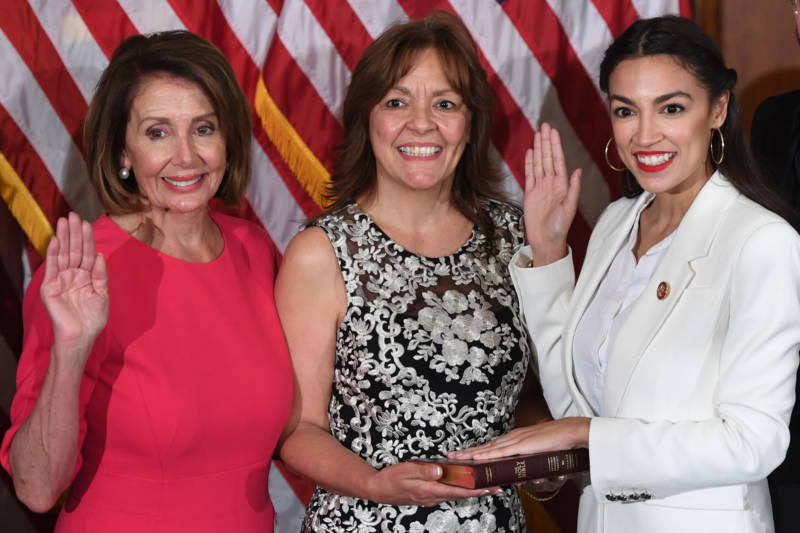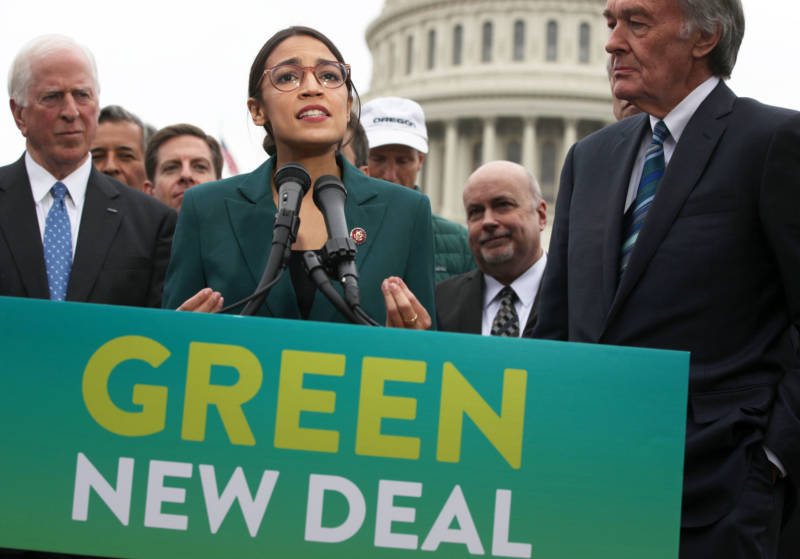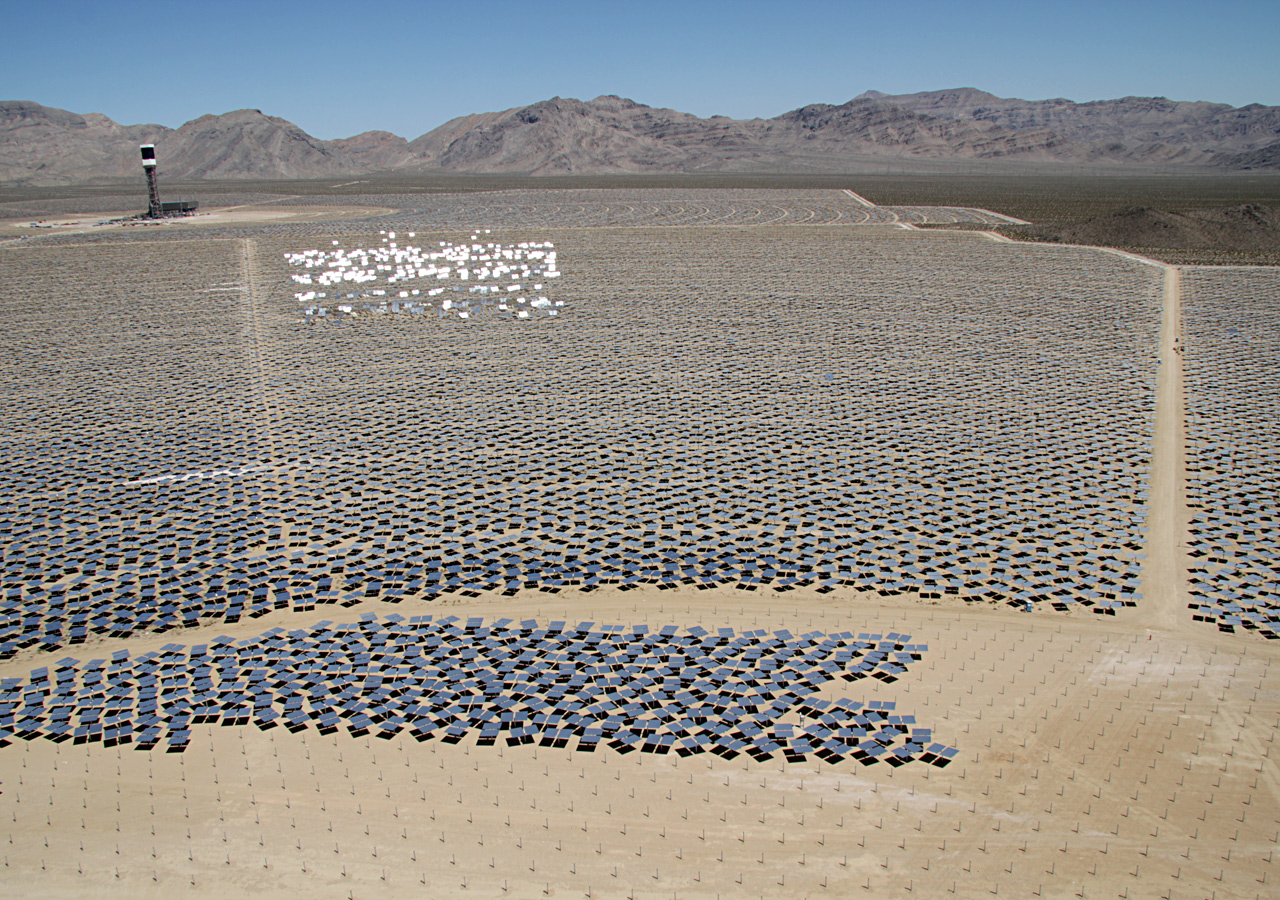Whether it’s a deadly cold snap or a hole under an Antarctic glacier or a terrifying new report, there seem to be constant reminders now of the dangers that climate change poses to humanity.
Rep. Alexandria Ocasio-Cortez, D-N.Y., and Sen. Ed Markey, D-Mass., think they have a start to a solution. Thursday they introduced a framework defining what they call a “Green New Deal” — what they foresee as a massive policy package that would remake the U.S. economy and, they hope, eliminate all U.S. carbon emissions.
At least five Democratic presidential hopefuls in the Senate — Kamala Harris of California, Cory Booker of New Jersey, Kirsten Gillibrand of New York, Elizabeth Warren of Massachusetts and Bernie Sanders of Vermont — co-sponsored the resolution.
While House Speaker Nancy Pelosi said she welcomed “the enthusiasm,” she fell short of endorsing it — noting she had not yet read the resolution. “I welcome the new deal and any other proposals,” said Pelosi.

Part of Pelosi’s concern may be that it’s a really big — potentially impossibly big — undertaking.
Ocasio-Cortez said, however, that’s exactly what’s needed. And she downplayed perceptions of criticism from the House Speaker, telling the Associated Press she’s on good terms with the California Democrat.
“Even the solutions that we have considered big and bold are nowhere near the scale of the actual problem that climate change presents to us,” Ocasio-Cortez told NPR’s Steve Inskeep in an interview that aired Thursday on Morning Edition.
She added: “It could be part of a larger solution, but no one has actually scoped out what that larger solution would entail. And so that’s really what we’re trying to accomplish with the Green New Deal.”
What is the Green New Deal?
In very broad strokes, the Green New Deal legislation laid out by Ocasio-Cortez and Markey sets goals for some drastic measures to cut carbon emissions across the economy, from electricity generation to transportation to agriculture. In the process, it aims to create jobs and boost the economy.
In that vein, the proposal stresses that it aims to meet its ambitious goals while paying special attention to groups like the poor, disabled and minority communities that might be disproportionately affected by massive economic transitions like those the Green New Deal calls for.
Importantly, it’s a nonbinding resolution, meaning that even if it were to pass (more on the challenges to that below), it wouldn’t itself create any new programs. Instead, it would potentially affirm the House’s intention that these things should be done in the coming years.
Lawmakers pass nonbinding resolutions for things as simple as congratulating Super Bowl winners, as well as to send political messages — for example, telling the president they disapprove of his trade policies, as the Senate did in summer 2018.
What are the specifics of that framework?
The bill calls for a “10-year national mobilizations” toward accomplishing a series of goals that the resolution lays out.
(Note: Ocasio-Cortez’s office released an updated version of the bill on Thursday. The earlier version, which was included in a prior version of this story, is still available here.)
Among the most prominent issues, the deal calls for “meeting 100 percent of the power demand in the United States through clean, renewable, and zero-emission energy sources.” The ultimate goal is to stop using fossil fuels entirely, Ocasio-Cortez’s office told NPR, as well as to transition away from nuclear energy.
In addition, the framework, as described in the legislation as well as a blog post and “FAQs” from Ocasio-Cortez’s office, calls for a variety of other lofty goals:
- “upgrading all existing buildings” in the country for energy efficiency;
- working with farmers “to eliminate pollution and greenhouse gas emissions … as much as is technologically feasible” (while supporting family farms and promoting “universal access to healthy food”);
- “overhauling transportation systems” to reduce emissions — including expanding electric car manufacturing, building “charging stations everywhere,” and expanding high-speed rail to “a scale where air travel stops becoming necessary”;
- a guaranteed job “with a family-sustaining wage, adequate family and medical leave, paid vacations and retirement security” for every American;
- “high-quality health care” for all Americans.
Which is to say: the Green New Deal framework combines big climate-change-related ideas with a wish list of progressive economic proposals that, taken together, would touch nearly every American and overhaul the economy.
Are those ideas doable?
Many in the climate science community, as well as Green New Deal proponents, agree that saving the world from disastrous effects of climate change requires aggressive action.
And some of the Green New Deal’s goals are indeed aggressive. For example, Ocasio-Cortez told NPR that “in 10 years, we’re trying to go carbon-neutral.”
According to Jesse Jenkins, a postdoctoral environmental fellow at Harvard’s Kennedy School, that may be an unreachable goal.
“Where we need to be targeting really is a net-zero carbon economy by about 2050, which itself is an enormous challenge and will require reductions in carbon emissions much faster than have been achieved historically,” he said. “2030 might be a little bit early to be targeting.”


